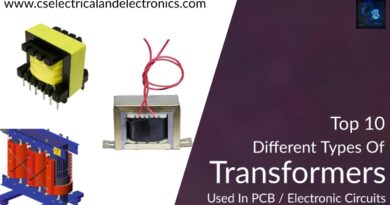What Is ECU In Vehicles, Electronic Control Unit, Purpose, Types
Hello guys, welcome back to our blog. Here in this article, we will discuss what is ECU in vehicles, the electronic control unit, the purpose of ECU, the types of ECU used in a vehicle, and the working of ECU.
If you have any electrical, electronics, and computer science doubts, then ask questions. You can also catch us on Instagram – CS Electrical & Electronics.
Also, read:
- Top 20 Real-Time Power System Monitoring Software
- Top 20 Latest Innovations In VLSI Domain, VLSI Technologies
- Types Of Electric Vehicle Charging Stations, Different Levels
What Is ECU In Vehicles, Electronic Control Unit
A device that manages numerous electrical and electronic systems in a machine, vehicle, or other intricate system is known as an electronic control unit (ECU). It serves as the system’s central processing unit, processing data from sensors and other sources before delivering output signals to actuators and other parts to regulate their functioning.
ECUs are used in a variety of systems, including industrial process control systems and automotive engine management systems. A CPU, memory, input, and output circuits, and specialized software created to carry out particular tasks are often present in them.
The ECU is in charge of managing the engine’s fuel injection, ignition timing, and other crucial variables in automotive applications to make sure the engine runs effectively and complies with pollution regulations. The gearbox, brakes, and suspension systems are just a few of the additional components that it can handle.
ECUs have the ability to be programmed and reprogrammed to change their behavior, enabling customization and performance improvement of the system. They are a fundamental part of contemporary systems and machines and ensure the safe and effective running of those systems and machines.
Here are some additional details about electronic control units:
01. Types of ECUs: ECUs come in a wide variety of sorts, each of which is intended to control a particular system or subsystem inside a bigger system. Engine control modules (ECMs), transmission control modules (TCMs), and body control modules are a few examples of popular automotive ECU types (BCMs).
02. Input sensors: In order to monitor the system’s functioning and make modifications as necessary, ECUs rely on data from a variety of sensors. Oxygen sensors, throttle position sensors, coolant temperature sensors, and numerous other types are typical sensors. The ECU uses this real-time input data to perform calculations and make decisions about how to modify the operation of the system.
03. Output actuators: In order to control the operation of output actuators such as fuel injectors, spark plugs, solenoids, and motors, ECUs also send signals to these components. Based on the input data it receives, the ECU sends signals that are intended to make sure the system functions effectively and efficiently.
04. Diagnostic capabilities: Several ECUs come equipped with built-in diagnostic tools that enable technicians to identify and fix systemic issues. These diagnostic tools can help find the source of any faults and can offer useful information about the system’s performance.
05. Programming and tuning: ECUs can be adjusted and programmed to change how they behave and perform. This may entail adjusting variables like as shift points, fuel and ignition timing, and other system settings. Professional mechanics can tune a vehicle using specialist software, while car owners can use aftermarket tuning equipment.
Overall, ECUs are crucial parts of contemporary machinery and systems, and because of their complex capabilities, these systems run effectively, safely, and dependably.
Working of ECU or Electronic Control Unit
The working of an electronic control unit (ECU) can be summarized in the following steps:
01. Input from sensors: The ECU receives input from various sensors, such as temperature sensors, pressure sensors, and position sensors. These sensors monitor the system’s performance and provide data on critical parameters, such as engine speed, coolant temperature, and throttle position.
02. Processing data: The ECU processes the input data it gets from the sensors using specific software algorithms before making judgments about how to modify the operation of the system. These choices are made in accordance with parameters and regulations that have been preprogrammed into the software of the ECU.
03. Output signals: Many actuators, including fuel injectors, spark plugs, and solenoids, get output signals from the ECU. These signals are intended to regulate the operation of various parts and guarantee the smooth and effective operation of the system.
04. Feedback control: The ECU continuously assesses the functioning of the system and modifies its output signals as necessary to keep the intended operating parameters. This procedure, known as feedback control, makes sure the system performs at its best in any circumstance.
05. Diagnostic capabilities: Additionally, the ECU features built-in diagnostic tools that enable technicians to identify and fix systemic issues. These diagnostic tools can help locate the source of any faults and offer useful information on the system’s performance.
In conclusion, an ECU serves as the system’s brain, processing data from sensors and communicating output signals to actuators to regulate system behavior. The system functions successfully and efficiently because of its advanced algorithms and feedback control capabilities, and its diagnostic skills make it easier for specialists to identify and fix any issues that may occur.
Types Of ECU (Electronic Control Unit)
There are several types of electronic control units (ECUs) used in various applications. Here are some common types of ECUs:
01. Engine Control Module (ECM): The engine’s operation, including fuel injection, ignition timing, and other crucial factors, is managed by the ECM, an engine control unit. It uses data from a number of sensors, including the oxygen sensor, throttle position sensor, and crankshaft position sensor, to track the performance of the engine and make necessary modifications.
02. Transmission Control Module (TCM): An ECU that manages the operation of the transmission is called the TCM. In order to monitor the transmission’s performance and modify shift points and other parameters as necessary, it gets data from a variety of sensors, including the vehicle speed sensor, throttle position sensor, and transmission fluid temperature sensor.
03. Body Control Module (BCM): Lighting, power windows, and door locks are just a few of the electrical systems in a car that are managed by the BCM, an ECU. To control the operation of these devices, it takes input from a variety of switches and sensors, including the headlight switch, door lock switch, and ambient light sensor.
04. Powertrain Control Module (PCM): The PCM is an ECU that combines the TCM and ECM’s features into one device. It is frequently utilized in contemporary vehicles to simplify the operation of these systems and regulates both the engine and transmission.
05. Electronic Brake Control Module (EBCM): The anti-lock braking system (ABS) and other brake-related systems are operated by the EBCM, an ECU. To monitor the performance of the braking system and make modifications as necessary, it gets data from a variety of sensors, including the wheel speed sensors and brake pedal position sensors.
These are but a few illustrations of the various ECU types utilized in various applications. Each type of ECU is intended to control a particular system or subsystem inside a larger system, and each one is essential to the smooth and functional operation of the system.
This was about “What Is ECU In Vehicles, Electronic Control Unit“. I hope this article may help you all a lot. Thank you for reading.
Also, read:
- 100 + Electrical Engineering Projects For Students, Engineers
- 1000+ Electronics Projects For Engineers, Diploma, MTech Students
- 1000+ MATLAB Simulink Projects For MTech, Engineering Students
- 500+ Embedded System Projects For Engineer, Diploma, MTech, PhD
- 500+ Projects For Diploma Electrical, Electronics Student, Diploma Project
- 8051 Microcontroller Timers, TCON Register, TMOD Register
- Advancements In 3D Printing Technology And It’s Future
- Advancements In Power Electronics For Energy Efficiency
Author Profile
- Chetu
- Interest's ~ Engineering | Entrepreneurship | Politics | History | Travelling | Content Writing | Technology | Cooking
Latest entries
 All PostsApril 19, 2024What Is Vector CANoe Tool, Why It Is Used In The Automotive Industry
All PostsApril 19, 2024What Is Vector CANoe Tool, Why It Is Used In The Automotive Industry All PostsApril 13, 2024What Is TCM, Transmission Control Module, Working, Purpose,
All PostsApril 13, 2024What Is TCM, Transmission Control Module, Working, Purpose, All PostsApril 12, 2024Top 100 HiL hardware in loop Interview Questions With Answers For Engineers
All PostsApril 12, 2024Top 100 HiL hardware in loop Interview Questions With Answers For Engineers All PostsMarch 22, 2024Driver Monitoring Systems In Vehicles, Working, Driver Sleepy Alert
All PostsMarch 22, 2024Driver Monitoring Systems In Vehicles, Working, Driver Sleepy Alert








